| 本文已被:浏览 563次 下载 1271次 |

码上扫一扫! |
|
|
| 几种褐藻多糖硫酸酯的提取、成分分析及抗氧化活性研究 |
|
李盛楠1, 王晶2,3, 于玮洁4, 卜晓翠1, 单体锋2,3
|
|
1.青岛大学附属心血管病医院, 山东 青岛 266071;2.中国科学院海洋研究所 海洋大科学研究中心, 山东省实验海洋生物学重点实验室, 山东 青岛 266071;3.崂山实验室海洋生物学与生物技术功能实验室, 山东 青岛 266237;4.青岛市食品药品检验研究院, 山东 青岛 266071
|
|
| 摘要: |
| 褐藻多糖硫酸酯是一种含有硫酸基的水溶性杂聚糖,其化学组成对抗氧化活性有较大的影响。本文对三种褐藻来源的褐藻多糖硫酸酯及其降解产物化学组成和抗氧化活性进行了研究,阐明了不同来源褐藻多糖硫酸酯体外抗氧化活性的构效关系。实验结果表明:1)分子量对抗氧化活性有较大影响,但是对不同褐藻来源的褐藻多糖硫酸酯的影响趋势并不一致。2)岩藻糖、硫酸基和糖醛酸含量对清除超氧阴离子自由基的影响与分子量有一定的关系。对于低分子量样品,岩藻糖和硫酸基含量与抗氧化活性成正相关。3)岩藻糖和硫酸根的比值对羟基自由基的清除能力有一定影响,比值越大,羟基自由基的清除能力越强。分子量、岩藻糖、硫酸基和糖醛酸的含量对褐藻多糖硫酸酯的抗氧化活性的影响依次减小。本研究为褐藻多糖硫酸酯在抗氧化剂保健品和功能食品中的应用提供了基础数据,也为裙带菜、羊栖菜和铜藻的高值化利用提供了理论依据。 |
| 关键词: 海藻多糖 化学组成 抗氧化活性 |
| DOI:10.11759/hykx20210803001 |
| 分类号:S917;TS254 |
| 基金项目:国家重点研发计划(2019YFD0900705) |
|
| Extraction, composition analysis, and antioxidant activity of polysaccharides from three species of seaweed |
|
LI Sheng-nan1, WANG Jing2,3, YU Wei-jie4, BU Xiao-cui1, SHAN Ti-feng2,3
|
|
1.The Affiliated Cardiovascular Hospital of Qingdao University, Qingdao 266071, China;2.Institute of Oceanology, Chinese Academy of Sciences, Center for Ocean Mega-Science, Shandong Province Key Laboratory of Experimental Marine Biology, Qingdao 266071, China;3.Qingdao National Pilot Laboratory of Marine Science and Technology, Laboratory for Marine Biology and Biotechnology, Qingdao 266237, China;4.Qingdao Institute for Food and Drug Control, Qingdao 266071, China
|
| Abstract: |
| Fucoidan sulfate is a water-soluble heteroglycan containing a sulfate group. Its chemical composition and structure collectively have a great impact on its antioxidant activity. In this paper, the chemical composition and antioxidant activity of crude polysaccharides and their degradation products from three species of seaweed were analyzed, and the structure-activity relationship of crude polysaccharides extracted from different seaweeds was explored. The following results were obtained:(1) Molecular weight has a great influence on antioxidant activity, but the influence trend shown by the brown algae polysaccharide sulfate from different algal sources is not consistent; (2) the effects of fucose, sulfate and uronic acid content on superoxide anion radical scavenging are related to molecular weight. To this end, for the low molecular weight samples, the higher the contents of the fucose and sulfate group, the stronger the superoxide anion radical scavenging activity; and (3) the ratio of fucose to sulfate has a direct effect on the scavenging ability of the hydroxyl radical, in other words, the greater the ratio of fucose to sulfate, the stronger the scavenging ability shown by the hydroxyl radical. The effects of molecular weight, fucose, sulfate group, and uronic acid content on the antioxidant activity of fucoidan sulfate decreased in this order. This study provides an experimental basis for the application of brown algal polysaccharide sulfate esters in antioxidant health products and functional foods, simultaneously providing a theoretical basis for the high-value commercial utilization of Undaria pinnatifida, Sargassum fusiforme, and copper algae. |
| Key words: seaweed polysaccharide chemical composition antioxidant activity |
